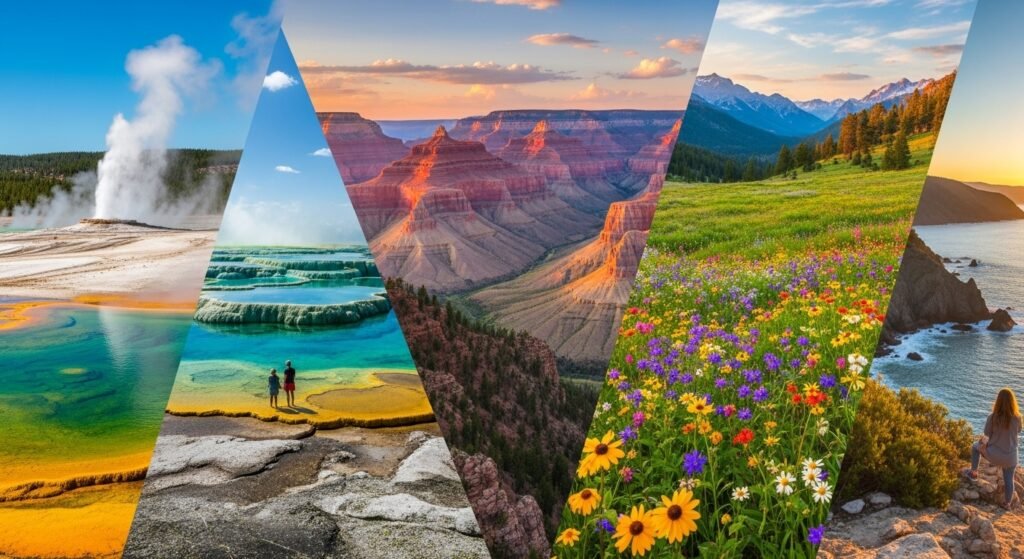
Dreaming of a summer escape that’s as Instagram-worthy as it is unforgettable? You’re in the right place. The United States is bursting with jaw-dropping destinations that come alive in the summer—think wildflower-strewn mountains, turquoise coastlines, and national parks that look like they were plucked straight from a postcard. Whether you’re a road tripper, a beach bum, or a mountain explorer, this guide will help you discover the prettiest places to visit in the USA this summer.
Ready to book your adventure? Explore these exclusive summer travel packages on Expedia, where you can find deals on flights, accommodations, and car rentals for all these stunning destinations.
What sets this list apart? We’ve analyzed the top-ranking travel guides, scoured recent traveler reviews, and dug into the latest tourism data to bring you a fresh, expert-backed selection. You’ll find not just the classics, but also a few hidden gems and unique angles that most lists miss. Plus, we’ll share insider tips, fun facts, and practical advice to make your trip planning a breeze.
So grab your sunglasses, dust off your camera, and let’s dive into America’s most beautiful summer escapes!
Majestic National Parks
America’s national parks showcase some of nature’s most spectacular works of art, from geothermal wonders to massive canyons. Summer brings these landscapes to life with vibrant colors, active wildlife, and perfect hiking conditions. Here are the most breathtaking national parks to visit this summer.
Yellowstone National Park, Wyoming/Montana/Idaho
America’s first national park remains one of its most spectacular. Summer transforms Yellowstone into a vibrant wonderland where wildlife roams freely across vast meadows and forests. The park’s 2.2 million acres contain over 10,000 geothermal features, including the iconic Old Faithful geyser that erupts approximately every 90 minutes, shooting water up to 185 feet into the air.
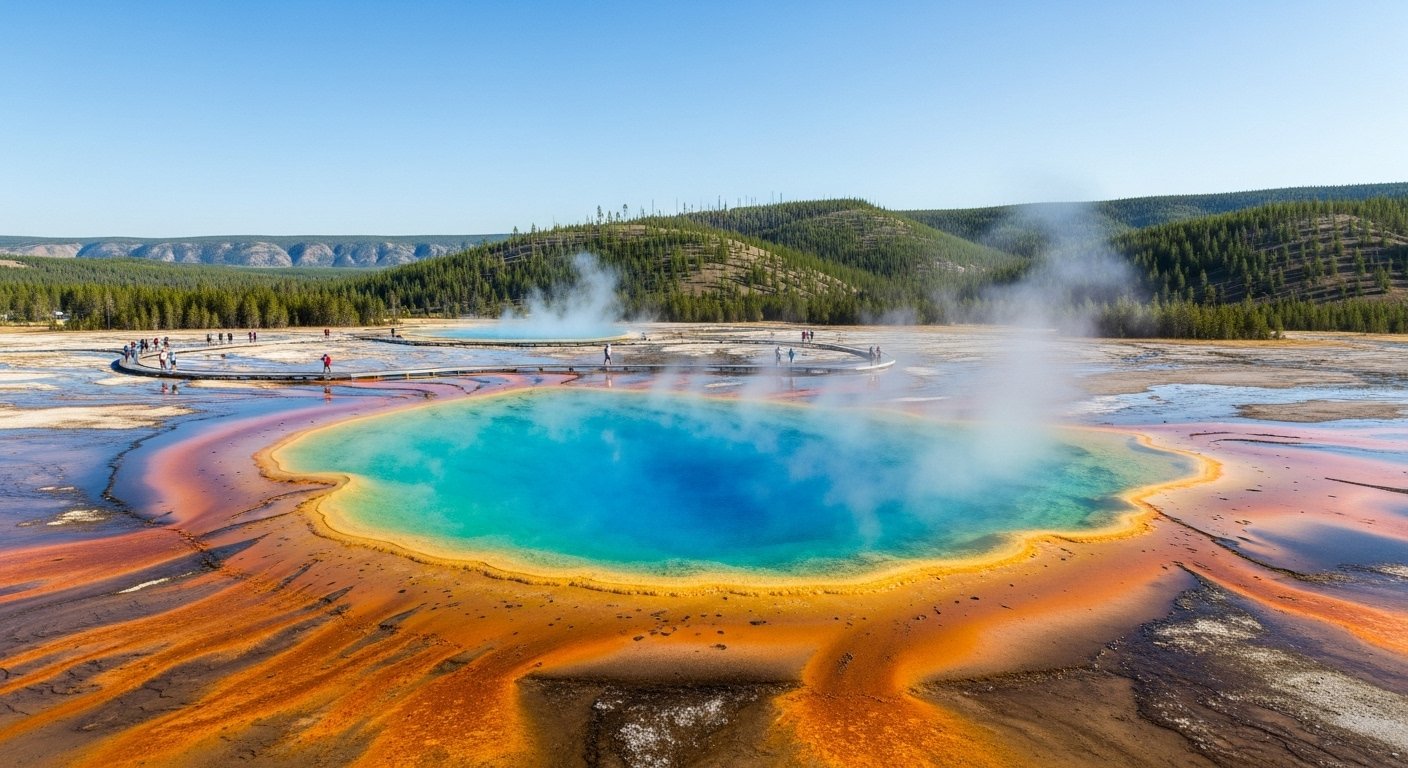
What makes summer special here? Between June and August, all park roads and facilities are fully operational, wildlife is highly active, and temperatures hover at a comfortable 70-80°F during the day. This is prime time to witness the rainbow-colored Grand Prismatic Spring in all its glory—at 370 feet wide and over 121 feet deep, it’s the third-largest hot spring in the world.
For the best experience, arrive at popular attractions before 9 AM or after 3 PM to avoid the midday crowds. The Lamar Valley, often called “America’s Serengeti,” offers the best wildlife viewing opportunities, especially at dawn and dusk when wolves, bears, and bison are most active.
Planning your Yellowstone adventure? Check out these highly-rated Yellowstone lodging options through Expedia.com, where you can find everything from rustic cabins to luxury accommodations within minutes of the park’s major attractions.
Grand Canyon, Arizona
The Grand Canyon’s massive scale—277 miles long, up to 18 miles wide, and over a mile deep—creates one of the world’s most awe-inspiring landscapes. Summer brings extended daylight hours, allowing visitors to witness both the golden sunrise and the fiery sunset that paint the canyon walls with vibrant oranges, reds, and purples.

The South Rim, open year-round and home to Grand Canyon Village, offers the most accessible viewpoints and amenities. For a more secluded experience, the North Rim (open mid-May through October) sits 1,000 feet higher and receives just 10% of the park’s visitors despite offering equally spectacular views.
Did you know? The Grand Canyon contains rock layers that reveal 2 billion years of Earth’s geological history—nearly half the planet’s age. The Colorado River continues to carve the canyon deeper by about the thickness of a sheet of paper each year.
Beat the summer heat (which can reach 100°F at the rim and 120°F at the bottom) by hiking early in the morning, carrying at least one gallon of water per person per day, and taking advantage of the free shuttle buses that connect viewpoints along the South Rim.
Want to experience the Grand Canyon without the planning hassle? Discover these top-rated Grand Canyon tours through GetYourGuide, where expert guides share fascinating geological and cultural insights while handling all the logistics for you.
Glacier National Park, Montana
Known as the “Crown of the Continent,” Glacier National Park features over 700 lakes, 175 mountains, and 26 remaining glaciers (down from 150 in 1850). Summer visitors can drive the famous 50-mile Going-to-the-Sun Road, which crosses the Continental Divide at Logan Pass (6,646 feet) and offers spectacular panoramic views of alpine meadows, rugged mountains, and glacial lakes.

July and August bring peak wildflower season, with over 1,000 species of plants blooming across the park’s varied ecosystems. The colorful display includes purple lupine, red Indian paintbrush, and yellow glacier lilies carpeting meadows and mountainsides.
For the ultimate Glacier experience, hike to Hidden Lake Overlook from Logan Pass (a moderate 2.7-mile round trip) or take a boat tour on Lake McDonald, the park’s largest lake at 10 miles long and 472 feet deep. Wildlife enthusiasts should keep their eyes peeled for mountain goats, bighorn sheep, and the occasional grizzly bear.
Zion National Park, Utah
Zion National Park is a wonderland of tall red rock cliffs, narrow canyons, and hanging gardens. The Virgin River flows through it all, creating a green ribbon in the desert landscape and continuing to carve the main canyon deeper. The park’s name, given by Mormon settlers in the 1860s, means “place of peace and refuge”.

Summer allows access to iconic hikes like The Narrows, where visitors wade through the Virgin River between canyon walls that soar up to 1,000 feet high and narrow to just 20-30 feet wide in places. For the adventurous, Angels Landing offers breathtaking views from its precipitous 1,488-foot summit, reached via a trail that includes 21 steep switchbacks (known as Walter’s Wiggles) and a final section along a narrow ridge with chains for handholds.
Emerald Pools, a series of pools and waterfalls accessed via trails of varying difficulty, provide a refreshing destination on hot summer days. The Lower Emerald Pool Trail (1.2 miles round trip) is suitable for most visitors and leads to a verdant oasis beneath a dripping cliff.
The park’s shuttle system operates fully during summer, making it easy to access all the major attractions without the hassle of parking. For a unique perspective, consider renting bikes to explore the canyon floor or taking a guided horseback ride through the park.
Need hiking gear for Zion’s adventures? Browse these specialized water shoes and hiking equipment on Amazon, perfect for navigating The Narrows and other water-based hikes in Zion National Park, with fast shipping and excellent customer reviews.
Breathtaking Coastal Escapes
From rugged cliffs to pristine beaches, America’s coastlines offer some of the most photogenic summer destinations. These coastal escapes combine natural beauty with charming towns, outdoor activities, and refreshing ocean breezes—perfect for beating the summer heat.
Napali Coast, Kauai, Hawaii
Hawaii’s Napali Coast features emerald cliffs rising dramatically 4,000 feet from the blue Pacific Ocean, with waterfalls cascading down wrinkled mountainsides and hidden beaches nestled between the cliffs. This 17-mile stretch along Kauai’s northwest shore is accessible only by boat, helicopter, or the challenging Kalalau Trail.
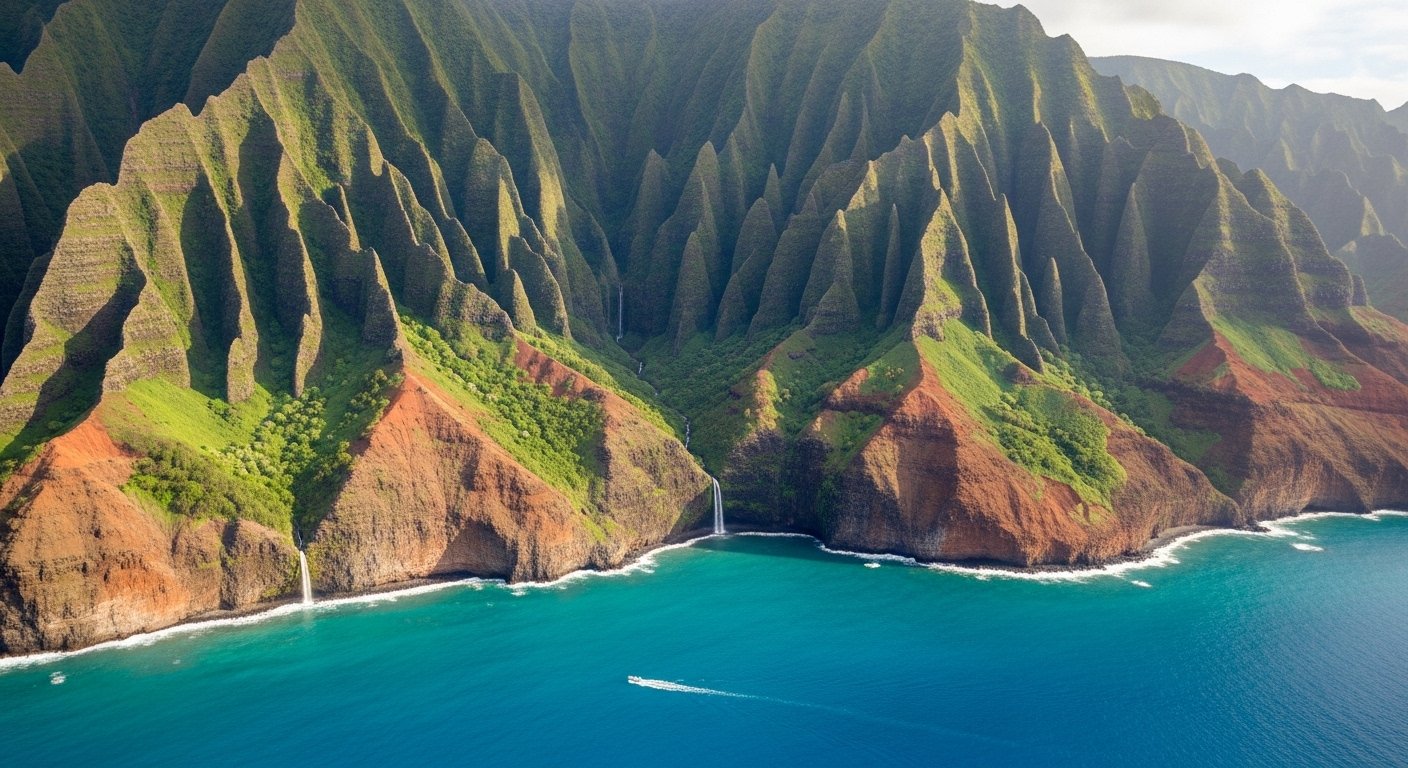
Summer (May through September) offers the calmest ocean conditions, making it the perfect time for boat tours, kayaking expeditions, or snorkeling at Tunnels Beach, where a vast reef system creates a habitat for over 150 species of fish and Hawaiian green sea turtles.
For the most breathtaking views, splurge on a helicopter tour that takes you into otherwise inaccessible valleys and alongside towering waterfalls. Movie buffs will recognize the landscape from films like “Jurassic Park,” “King Kong,” and “Pirates of the Caribbean.”
Did you know? The Napali Coast’s dramatic landscape was formed by erosion from rain and waves over millions of years, carving deep valleys into the volcanic rock.
Want to experience the Napali Coast from every angle? Discover these highly-rated Napali Coast boat tours through GetYourGuide, where experienced captains navigate along the coastline, sharing local knowledge while providing opportunities for wildlife spotting and snorkeling.
Cannon Beach, Oregon
Cannon Beach on Oregon’s coast is famous for its dramatic shoreline dominated by Haystack Rock, a 235-foot sea stack that serves as a nesting site for tufted puffins in early summer. This monolithic rock formation emerges from the ocean like a sentinel, creating one of the most photographed scenes on the Pacific Coast.
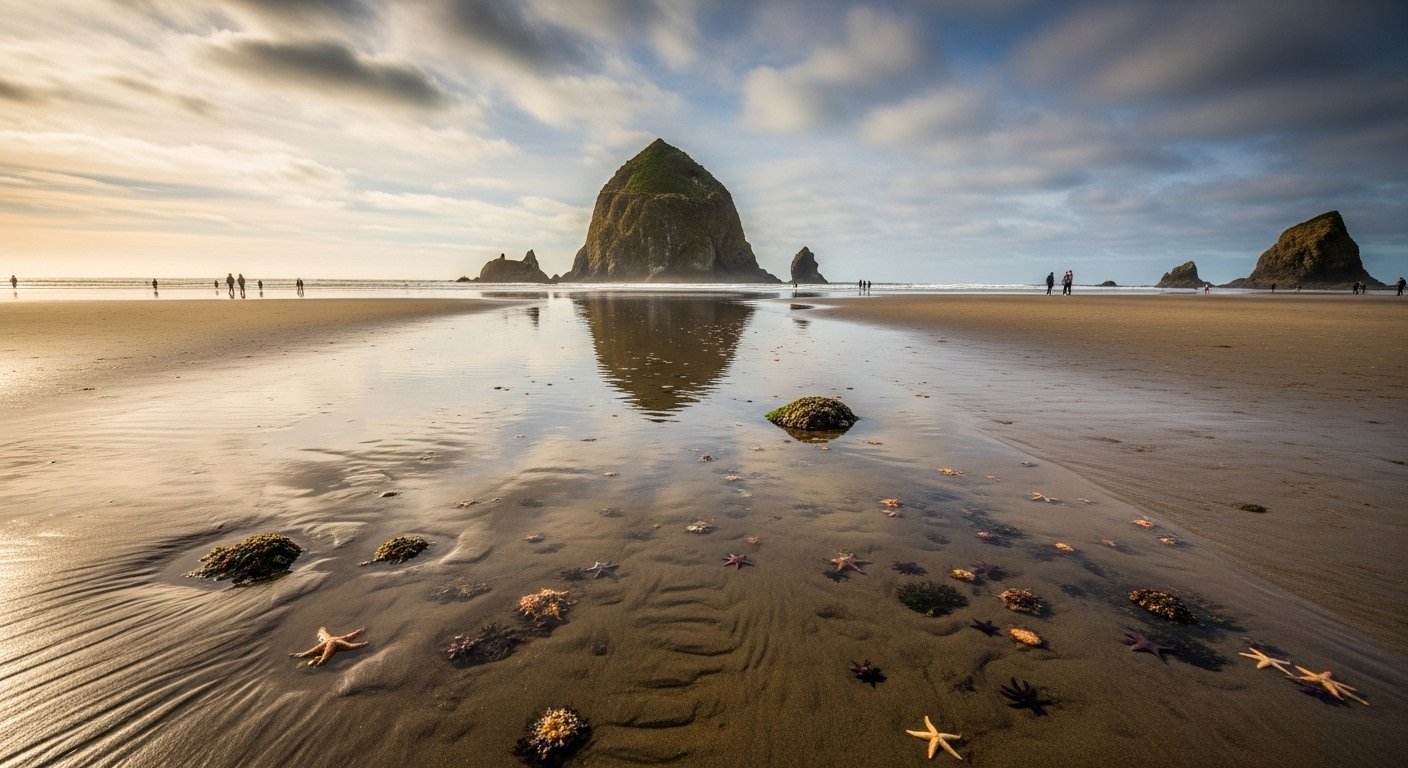
Summer brings warmer temperatures (60-70°F) and clearer skies to this normally misty region, making it ideal for exploring the 9 miles of scenic shoreline. Low tide reveals colorful tidepools around Haystack Rock, where visitors can spot starfish, sea anemones, and hermit crabs under the watchful guidance of volunteer “Rock Stars” who educate about marine conservation.
The charming town of Cannon Beach, with its art galleries, boutique shops, and seafood restaurants, has been named one of “The 100 Best Art Towns in America”. Nearby Ecola State Park offers hiking trails with panoramic views of the coastline and the chance to spot migrating gray whales from March through June.
Planning a coastal Oregon road trip? Explore these scenic Pacific Northwest accommodations on Vrbo, where you can find beachfront cottages and forest retreats with easy access to Oregon’s most beautiful coastal attractions.
Outer Banks, North Carolina
This 200-mile string of barrier islands offers some of America’s most pristine beaches, towering sand dunes, and historic lighthouses. The Cape Hatteras Lighthouse, with its distinctive black-and-white spiral pattern, stands 210 feet tall as the tallest brick lighthouse in North America.
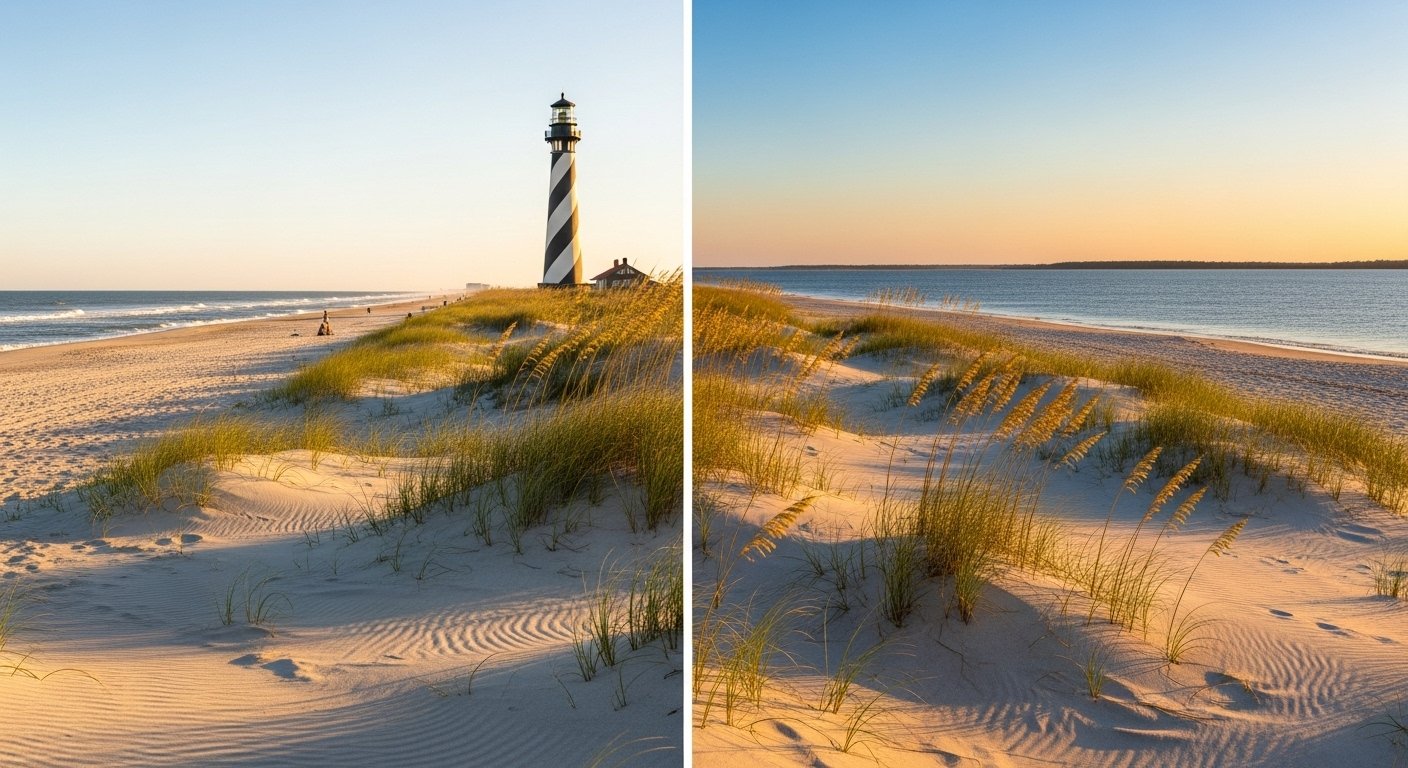
Summer brings perfect beach weather with water temperatures reaching the mid-70s, ideal for swimming, surfing, and paddleboarding. The constantly shifting sands create new landscapes daily, while the unique positioning of the islands allows visitors to watch both sunrise over the Atlantic Ocean and sunset over the Pamlico Sound.
Wildlife enthusiasts can spot wild horses that have roamed freely on Corolla and Ocracoke Island for nearly 500 years, descendants of Spanish mustangs that survived shipwrecks. For adventure seekers, Jockey’s Ridge State Park features the tallest natural sand dune system in the eastern United States, perfect for sandboarding and hang gliding.
Ready to book your Outer Banks getaway? Check out these oceanfront vacation rentals on VRBO, where you can find everything from cozy beach cottages to luxurious family homes with private beach access and stunning views.
Acadia National Park, Maine
Acadia National Park represents the perfect marriage of mountains and sea on Maine’s rugged coastline. As the first national park east of the Mississippi River, it preserves 47,000 acres of rocky beaches, woodland, and glacier-scoured granite peaks.

Summer brings comfortable temperatures (65-75°F) and the perfect conditions for hiking Cadillac Mountain—at 1,530 feet, it’s the highest point on the North Atlantic seaboard and the first place in the United States to see the sunrise for much of the year. The park’s 45 miles of carriage roads, built by John D. Rockefeller Jr. between 1913 and 1940, offer car-free biking and walking paths through forests and past stone bridges.
Don’t miss Thunder Hole, a natural rock formation where incoming waves create a thunderous sound and spectacular splash that can reach up to 40 feet high when conditions are right. For a quintessential Maine experience, enjoy fresh lobster in the charming town of Bar Harbor after a day of exploring.
Looking for accommodation near Acadia? Explore these charming Bar Harbor bed and breakfasts on Hotels.com, where you can experience authentic New England hospitality within minutes of Acadia National Park’s entrance.
Mountain Retreats & Desert Wonders
From colorful rock formations to misty mountain vistas, these destinations showcase the diverse beauty of America’s inland landscapes. Summer brings these areas to life with wildflowers, wildlife activity, and perfect conditions for outdoor exploration.
Maroon Bells, Colorado
The twin peaks of the Maroon Bells, reflected perfectly in Maroon Lake, create one of America’s most photographed mountain scenes. Rising to over 14,000 feet, these distinctive bell-shaped mountains get their maroon color from the weathering of hematite (iron-bearing mineral) in the mudstone that makes up the peaks.
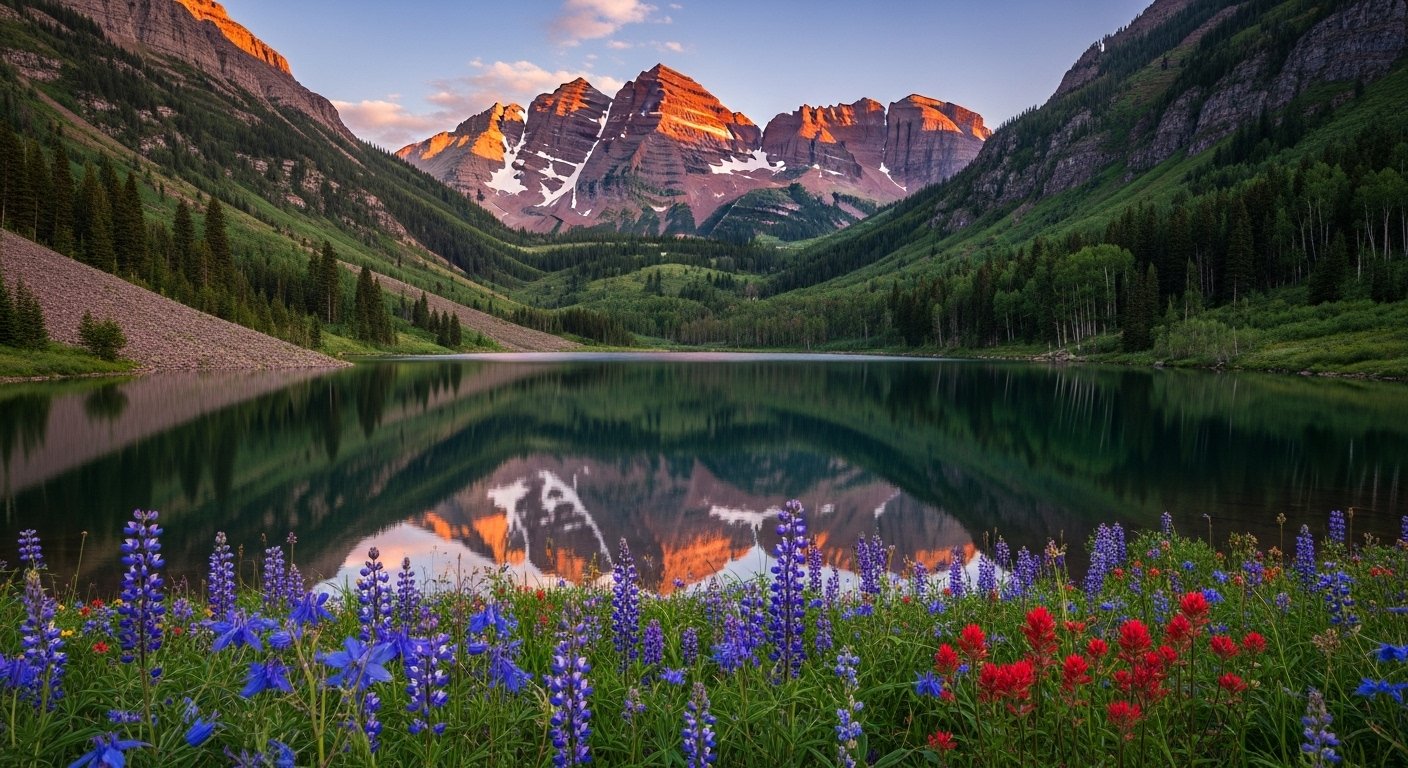
Summer transforms the landscape with wildflowers blooming in meadows and aspen trees providing vibrant green backdrops to the purple-red mountains. July brings peak wildflower season, with columbines (Colorado’s state flower), lupines, and Indian paintbrush creating a natural garden in the alpine meadows.
The most popular view is from the shores of Maroon Lake, accessible via shuttle bus from Aspen Highlands during peak summer months (parking is restricted). For a more immersive experience, hike the scenic Crater Lake Trail (3.6 miles round trip) or the more challenging Buckskin Pass (9.1 miles round trip), which offers panoramic views of the surrounding Elk Mountains.
Need accommodation in Aspen? Browse these luxury and budget-friendly Aspen hotels on Booking.com, with special summer rates and packages that include shuttle service to popular trailheads and attractions.
Great Smoky Mountains, Tennessee/North Carolina
America’s most visited national park (with over 12 million annual visitors) earns its popularity with misty mountain views that seem to stretch endlessly into the distance. The name comes from the natural fog that hangs over the mountains, creating the smoky appearance that Cherokee called “Shaconage” (place of blue smoke).
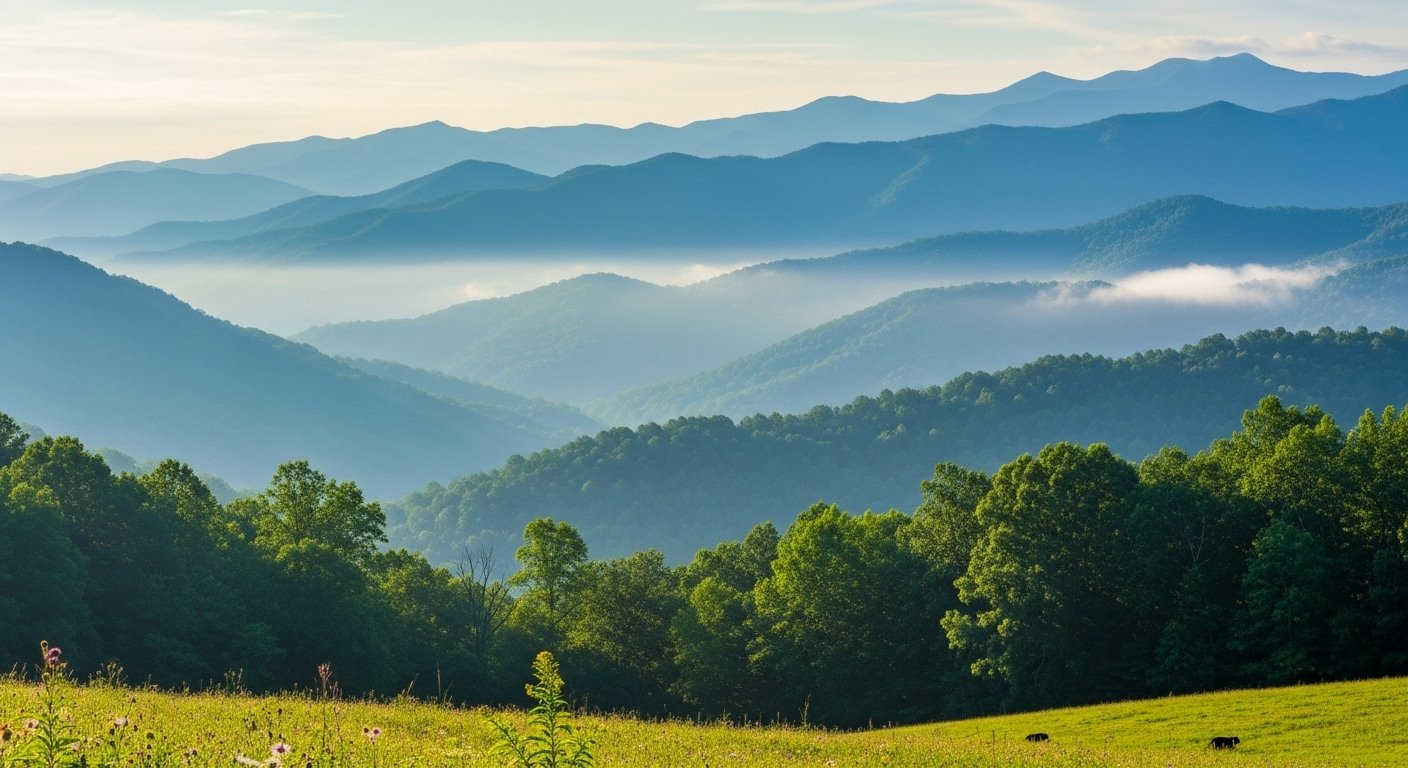
Summer brings the mountains to life with over 1,500 flowering plant species and abundant wildlife. The park contains more tree species than all of northern Europe and is considered the salamander capital of the world, with 30 different species.
Cades Cove, a broad valley surrounded by mountains, offers the park’s best wildlife viewing opportunities via an 11-mile one-way loop road. Early morning visitors often spot black bears, white-tailed deer, and wild turkeys. For spectacular views, drive to Clingmans Dome, the highest point in the park at 6,643 feet, where a half-mile trail leads to an observation tower with panoramic vistas across seven states on clear days.
Want to explore beyond the main attractions? Discover these hidden gem hiking trails in the Smokies through AllTrails Pro, where you can download offline maps and get turn-by-turn directions to lesser-known waterfalls and viewpoints away from the crowds.
Sedona, Arizona
Sedona’s red rock formations glow like fire at sunset against the blue Arizona sky, creating a landscape that feels almost otherworldly. These sandstone formations, sculpted by wind and water over millions of years, have names like Cathedral Rock, Bell Rock, and Coffee Pot Rock based on their distinctive shapes.
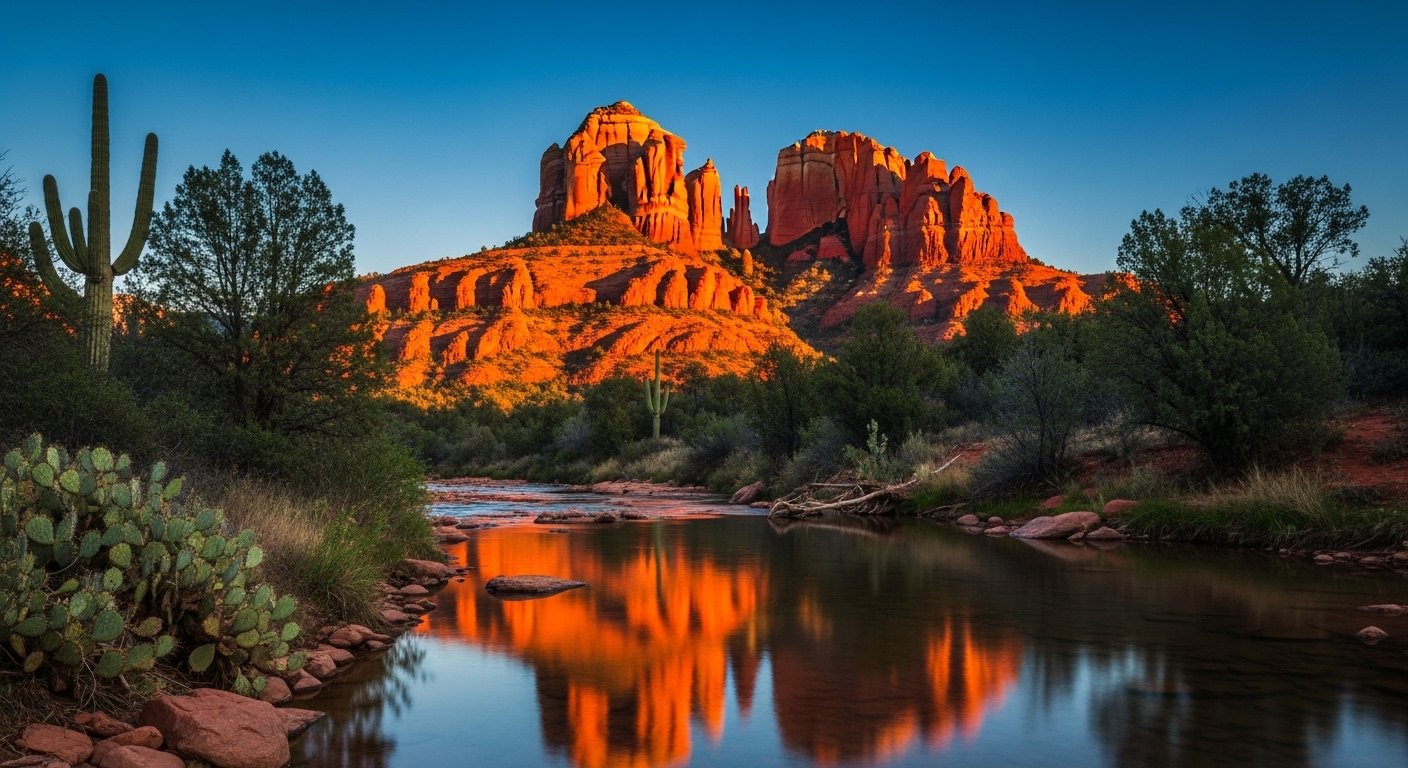
Summer mornings and evenings offer comfortable temperatures for exploring the numerous hiking trails that wind among the rocks. The 3.9-mile Cathedral Rock Trail rewards hikers with panoramic views from “the saddle,” while the 1.8-mile Devil’s Bridge Trail leads to the largest natural sandstone arch in the Sedona area.
Beyond natural beauty, Sedona is known for its vortexes—specific sites where energy is said to be especially strong. Whether or not you believe in their metaphysical properties, these sites (including Bell Rock, Cathedral Rock, and Airport Mesa) offer some of the most spectacular views in the area.
Sedona’s clear night skies, protected by strict light pollution ordinances, provide excellent stargazing opportunities. The town was designated the world’s eighth International Dark Sky Community in 2014.
Looking for a unique Sedona experience? Explore these highly-rated Sedona jeep tours through GetYourGuide, where knowledgeable local guides take you to hidden viewpoints and share insights about the geology, wildlife, and Native American history of the area.
Hidden Gems & Less-Traveled Destinations
While the iconic destinations deserve their fame, these lesser-known spots offer equally stunning scenery with smaller crowds. Perfect for travelers seeking unique experiences and Instagram-worthy views without the tourist masses.
Pictured Rocks National Lakeshore, Michigan
Colorful sandstone cliffs line Lake Superior at Pictured Rocks, creating nature’s own artwork along 15 miles of Michigan’s Upper Peninsula shoreline. Minerals have stained the rocks in shades of red, orange, blue, green, and brown, while waterfalls spill directly into the crystal-clear lake.

Summer brings warmer temperatures (70-80°F) and calmer waters, making it the ideal time to explore this often-overlooked national treasure. Boat tours offer the best views of the colorful formations, including famous landmarks like Miners Castle, Chapel Rock, and the 200-foot-tall Grand Portal.
For adventurous visitors, kayaking provides an up-close experience with the cliffs and sea caves. Several outfitters in the nearby town of Munising offer guided tours suitable for various skill levels.
Hikers can explore over 100 miles of trails, including the North Country Trail that follows the cliff tops and offers spectacular views from above. Don’t miss the 1.5-mile trail to Miners Beach and Miners Falls, where the Miners River drops 50 feet through a rock gorge surrounded by forest.
Planning a Great Lakes adventure? Discover these charming lakeside cabins and cottages on VRBO, located in Michigan’s scenic Upper Peninsula with easy access to Pictured Rocks and other natural attractions in the area.
Spring Lake, New Jersey
As a quieter alternative to the busier Jersey Shore destinations, Spring Lake offers a quaint downtown with local boutiques and restaurants, as well as expansive beaches with soft sand perfect for spending lazy summer days. This charming seaside community, nicknamed the “Irish Riviera” due to its large Irish-American population, features the longest non-commercial boardwalk in New Jersey at two miles.

Unlike the boardwalk-dominated Shore towns, Spring Lake provides a more relaxed beach experience with its Victorian architecture, tree-lined streets, and the namesake spring-fed lake in the center of town. The lake features a picturesque footbridge and is surrounded by manicured gardens and walking paths.
Summer brings warm ocean temperatures (70-75°F) and sunny days ideal for swimming and sunbathing. The town’s two pristine beaches are meticulously maintained and less crowded than neighboring communities, even during peak season.
Architecture enthusiasts will appreciate the historic district’s preserved Victorian homes, many dating back to the late 1800s when Spring Lake was developed as a coastal resort for wealthy New Yorkers and Philadelphians. The Normandy Inn, built in 1888, still operates as a hotel and restaurant, offering a glimpse into the town’s storied past.
Ready to experience the Jersey Shore’s hidden gem? Explore these elegant Spring Lake bed and breakfasts on Hotels.com, where you can experience the charm of historic Victorian inns just steps from the beach and downtown shopping district.
Antelope Canyon, Arizona
This narrow slot canyon features swirling orange walls that look like waves frozen in stone, created by flash floods eroding the Navajo sandstone over thousands of years. Located on Navajo land near Page, Arizona, Antelope Canyon is actually two separate sections: Upper Antelope Canyon (Tsé bighánílíní, meaning “the place where water runs through rocks”) and Lower Antelope Canyon (Hazdistazí, or “spiral rock arches”).
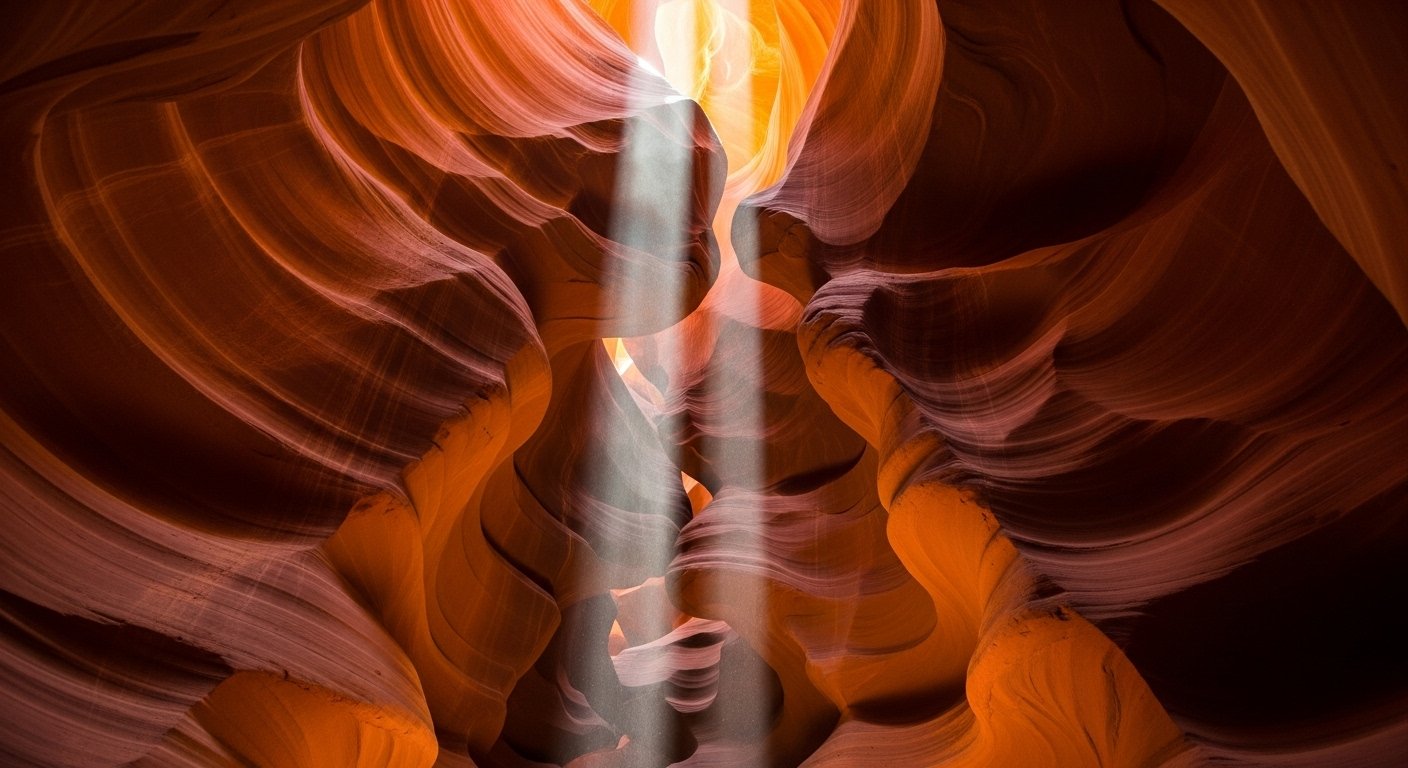
Summer brings the most dramatic light beams to Upper Antelope Canyon, typically around midday when the sun is highest. These shafts of light penetrate through cracks in the top of the canyon, creating spectacular light shows on the canyon floor that photographers travel worldwide to capture.
Lower Antelope Canyon, while lacking the famous light beams, offers equally stunning swirling patterns and is less crowded. It requires navigating stairs and ladders, making it slightly more adventurous.
Important note: Antelope Canyon can only be visited with an authorized Navajo guide, and tours often sell out months in advance during summer. Temperatures inside the canyon are cooler than outside, providing a welcome respite from the desert heat.
Want to guarantee your spot at Antelope Canyon? Check out these highly-rated Antelope Canyon guided tours through GetYourGuide, where you can secure your reservation with authorized Navajo guides who share the canyon’s cultural significance and help you capture perfect photographs.
Olympic National Park, Washington
Olympic National Park offers incredible diversity with its temperate rainforests, alpine meadows, and rugged coastline all within a single park. This UNESCO World Heritage Site encompasses nearly a million acres and three distinct ecosystems.
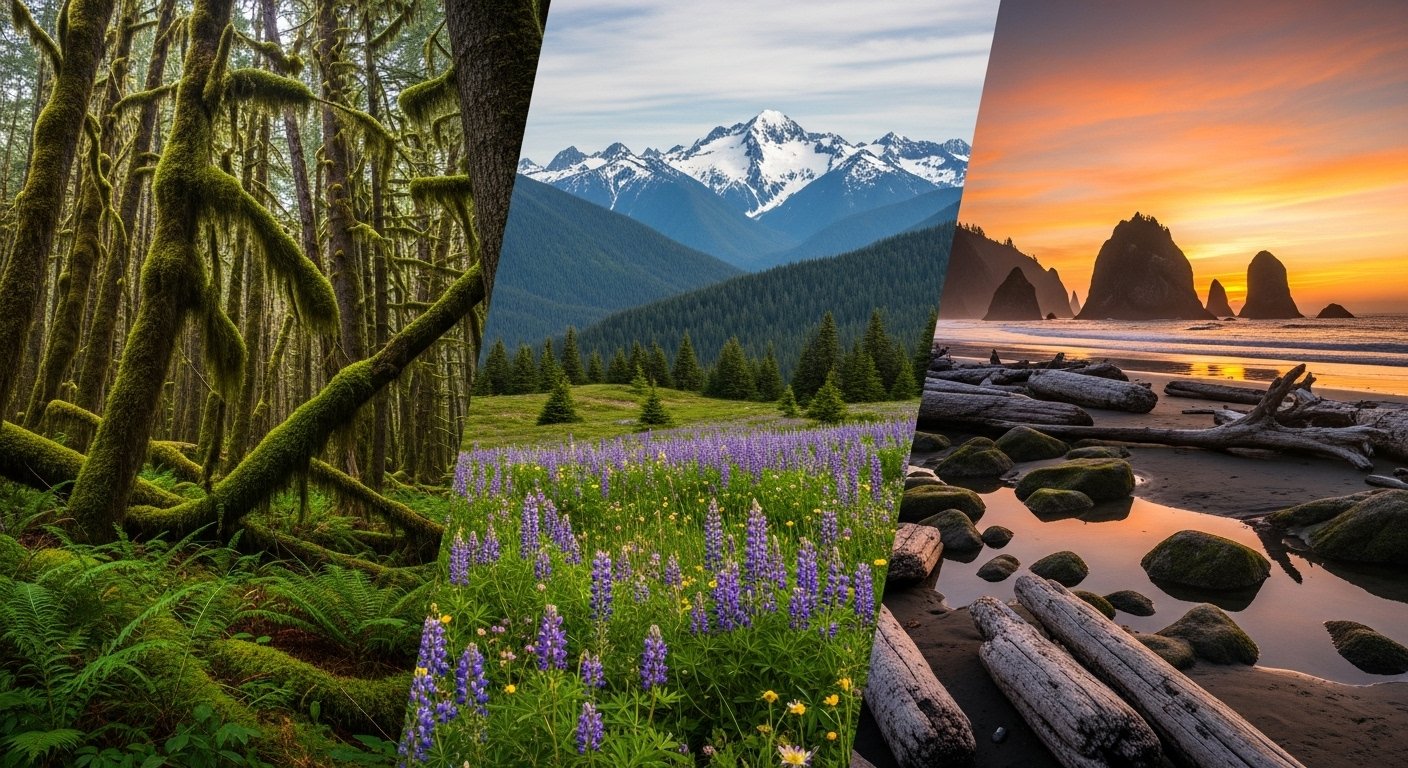
Summer visitors can experience the moss-draped Hoh Rain Forest, which receives up to 14 feet of rain annually, creating an emerald wonderland of giant Sitka spruce and western hemlock trees draped in mosses and ferns. Just an hour’s drive away, Hurricane Ridge (5,242 feet) offers subalpine meadows bursting with wildflowers and panoramic views of the Olympic Mountains, often still snow-capped into July.
The park’s 73 miles of wild coastline feature dramatic sea stacks, tide pools teeming with starfish and anemones, and driftwood-strewn beaches. Ruby Beach, with its distinctive rock formations and colorful pebbles, is particularly photogenic at sunset.
For a unique experience, visit Sol Duc Hot Springs, where you can soak in mineral pools surrounded by forest after hiking to nearby Sol Duc Falls, a 48-foot cascade that splits into multiple channels as it drops into a narrow canyon.
Need camping gear for your Olympic adventure? Shop REI’s comprehensive camping collection, featuring lightweight tents, weather-appropriate sleeping bags, and cooking equipment perfect for the varied conditions you’ll encounter in Olympic National Park.
Planning Your Perfect Summer Getaway
When to Visit: Timing Tips for Summer Travelers
For the most enjoyable experience at these beautiful destinations, consider these timing strategies:
Visit on weekdays: Most national parks and popular destinations see significantly lower crowds Monday through Thursday.
Early morning magic: Arrive at major attractions before 9 AM to beat both crowds and heat, especially in desert locations.
Late season advantage: Late August often offers perfect weather with smaller crowds as many families return home for the school year.
Where to Stay: Accommodation Strategies
Book early: For national parks, secure lodging 6-12 months in advance, especially for in-park accommodations.
Consider alternatives: Look for accommodations in gateway communities or nearby towns for better availability and rates.
Embrace camping: Many of these destinations offer spectacular campgrounds that put you closer to nature and save money.
How to Prepare: Essential Summer Travel Tips
Stay hydrated: Summer heat requires drinking more water than you might expect—at least 2-3 liters per day.
Layer clothing: Even summer destinations can experience significant temperature swings, especially in mountain and desert regions.
Protect from sun: Pack high-SPF sunscreen, UV-blocking sunglasses, and a wide-brimmed hat for outdoor activities.
Research permits: Some popular hikes and attractions require advance reservations or permits, especially in 2025.

Pingback: America's Best Small Town Summer Escapes: Where Locals Still Wave Hello - 15 Hidden Gems for 2025
Pingback: 15 Hidden Gems in Pennsylvania: Secret Places Locals Don't Want You to Know About (2025)